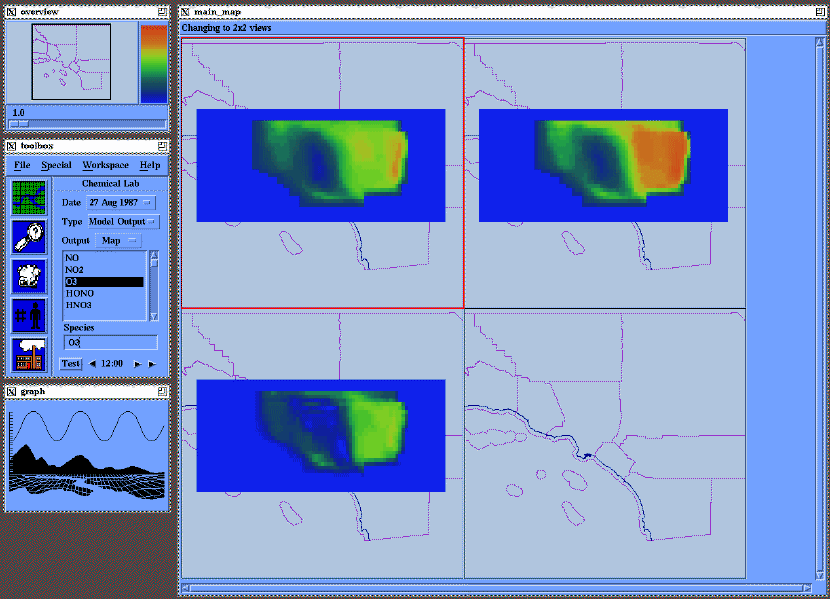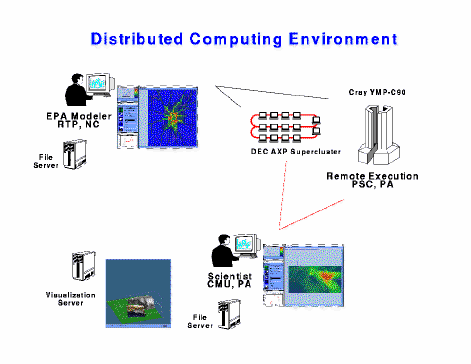The Geographic Environmental Modeling System (GEMS)
Contents
Framework Overview
The GEMS framework consists of five components, the
User Interface
provides a consistent interface to all the system capabilities. The
Execution
component provides control over air quality model calculations - the
user may choose from several different scientific models and
the diverse computational platforms available. The
Visualization
component provides advanced capabilities for viewing the data output
from the air quality model calculations. The
Data Management
component manages the data produced and consumed by all components of
the system. The
Monitoring
component provide capabilities for tracking performance and faults in
the distributed system on which all the components operate.
The Five Components of the GEMS Framework and the Current
Prototype Implementation

User Interface
The GEMS user interface provides capabilities for analysis of the data
generated by the underlying air quality models. Data from several
different control strategy scenarios can be compared in order to find
the "best" strategy. The picture below shows the interface while
comparing two sets of data from Los Angeles simulations. The first
pane (upper left) shows the data for the basecase measurements. The
second pane contains data from a modified run of the program done as
part of a sensitivity study - several parameters in the chemical
equations were varied to determine the sensitivity of ozone
concentrations to these types of perturbations. The third pane contains
a deficit enhancement plot showing the absolute difference between the
data in the first and second panes.
Control Strategy Comparison

Execution
The Execution component allows the user to choose the most appropriate
computational model and computing platform to use for a given
simulation. Current model choices include the single-scale CIT
Airshed Model, the multiscale Urban and Regional Model, and the EPA's
Urban Airshed Model. Computing platforms available include single
Alpha or SPARC workstations, a SuperCluster (or "farm") of Alpha
workstations connected with a high-speed network, the Cray C90 vector
supercomputer, or the Cray T3D massively-parallel machine. Parts of
the URM system are also available on the Intel Paragon and Intel iWarp
parallel platforms.
Choice of Models and Platforms

Visualization
The Visualization component provides advanced capabilities for viewing
the data generated by the air quality models. The picture below shows
an isosurface enclosing the volume of air where the concentration of
ozone exceeds the National Ambient Air Quality Standard (NAAQS) of
0.12 ppm. The map below the ozone cloud contains both LANDSAT
satellite imagery and political boundaries derived from the Census
Department's TIGER database.
Ozone Cloud over Los Angeles

Data Management
The Data Management component is responsible for all data stored by
GEMS and the air quality models. The system must provide support for
a variety of datatypes, storage sub-systems, and access patterns.
Different components of the system will be written in different
languages (currently - Fortran, C, and C++) and will run on a variety
of heterogeneous platforms. The data will also be physically
distributed on servers across the country. The Data Management
component must provide the appropriate data conversions between
different formats, provide location-transparent access for all
clients, and provide adequate performance (I/O operations should never
be the bottleneck in the system).
Distributed Data Servers and Clients

Monitoring
The Monitoring component allows the system and the user to keep track
of what is going on across the distributed system of machines that
constitute the GEMS system. Monitoring capabilities are used to
identify performance bottlenecks in the system, and provide
information about network and system faults as they occur. The
picture below shows output from the BEE monitoring system that is
currently being used with GEMS. The display shows the variation in
the load on several processors cooperating on a URM mutliscale model
calculation. The second picture gives some idea of the highly
distributed nature of the GEMS system. There may be modelers on the CMU
campus and at the EPA in North Carolina both making use of
resources at the PSC in Pittsburgh. The data used for different
evaluations might be stored at any of these three sites. In the
future, it should be possible for the modelers not only to share data
within the system, but also to collaborate interactively using the
same interface.
The BEE Monitoring System


CMU/HPCC/GEMS/Version 1.0/12-Nov-94/er1p






